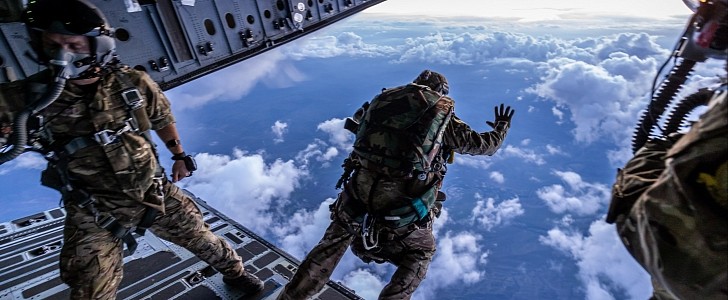Before paratroopers can kick off their missions, the Royal Air Force’s Pathfinders have to jump first, detecting enemy positions and establishing the best drop zones. This is what they did recently, during the Swift Response exercise in Northern Macedonia.
Back in the ‘80s, the McDonnell Douglas C-17 was selected as the U.S. Air Forces’ new transport aircraft. Complications down the road led to Boeing acquiring McDonnell Douglas and taking over the production of the C-17. By 1993, the Globemaster III was already an experienced heavy-lifter.
Around the same time, UK’s Royal Air Force (RAF) was lacking an aircraft that could fulfill the strategic lift role of the former Short Belfast.
In 2020, RAF signed a contract with Boeing and USAF for the C-17 Globemaster. Two decades later, the strategic transport aircraft is still going strong. For this military exercise, it took the Pathfinders from RAF Brize Norton over Northern Macedonia, where they jumped from 18,000 feet (5,486 meters).
They dropped into a specific training area, where they had to pave the way for the British, Italian, and French paratroopers that would be jumping in the following days.
The 174-foot-long (53 meters) beast can handle 100,000 lbs (45,360 kg) at over 35,000 feet (10,668 meters) while covering distances of around 4,500 nautical miles (5,178 miles/8,334 km). This basically means that the Globemaster can take things like military vehicles or Chinook helicopters anywhere in the world.
Plus, despite its size, it can land in challenging airfields and on runways that are no longer than 3,500 feet (1,066 meters) and no wider than 90 feet (27 meters).
As its name suggests, Swift Response allows NATO troops to practice a joint response to international crises. They’ll be deployed via parachutes and helicopters to practice complex defense and offense operations. The exercise began on April 21 and will continue until the end of May.
Around the same time, UK’s Royal Air Force (RAF) was lacking an aircraft that could fulfill the strategic lift role of the former Short Belfast.
In 2020, RAF signed a contract with Boeing and USAF for the C-17 Globemaster. Two decades later, the strategic transport aircraft is still going strong. For this military exercise, it took the Pathfinders from RAF Brize Norton over Northern Macedonia, where they jumped from 18,000 feet (5,486 meters).
They dropped into a specific training area, where they had to pave the way for the British, Italian, and French paratroopers that would be jumping in the following days.
The 174-foot-long (53 meters) beast can handle 100,000 lbs (45,360 kg) at over 35,000 feet (10,668 meters) while covering distances of around 4,500 nautical miles (5,178 miles/8,334 km). This basically means that the Globemaster can take things like military vehicles or Chinook helicopters anywhere in the world.
Plus, despite its size, it can land in challenging airfields and on runways that are no longer than 3,500 feet (1,066 meters) and no wider than 90 feet (27 meters).
As its name suggests, Swift Response allows NATO troops to practice a joint response to international crises. They’ll be deployed via parachutes and helicopters to practice complex defense and offense operations. The exercise began on April 21 and will continue until the end of May.







